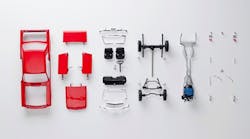In 2013 3Discovered was founded to become the first independent online exchange platform to facilitate the buying, selling, and fabricating of commercial-grade 3-D printed parts and products.
“We were intrigued by the notion that 3-D printing makes it easy to split a transaction for an object into its physical component (fabrication) and its intellectual property component (design),” the company explains on its website.
“Combine that with other 3-D printing benefits such as making what’s needed, when needed, where needed, and the freedom to design without constraints, and we saw an opportunity. So we set out to integrate these features by combining software and business processes with a network of multiple service bureaus in a commercial-grade cloud-based exchange platform.”
The company says that it offers a solution for any supply chain impeded by minimum order quantities, aging inventories, “long tail” products, legacy machines and discontinued parts.
The process the company follows comprises of fulfilling transactions between customers who desire a product, owners of the product designs, and third-party 3-D printing service bureaus that fabricate and ship the final product. Future versions will also incorporate “crowd-sourcing” of designs, third party certification, 3D printing engineering services, and workflow management.
The company has signed up 20 3-D printing firms and expects to have about 100 by year-end, as reported by Michah Maidenberg for Crains’ Chicago Business.
On the client site the company has a contract with Advanced Technology Services, which maintains factories for Caterpillar and Siemens. The account is an early win for 3Discovered, reports Maidenberg, since ATS has to keep about 125 industrial plants around the world functioning.
The advantage to ATS, which must manages 150,000 different parts for it's client's factories, is that it allows ATS to quickly source components no longer sold on the open market, order small batches,and get improved parts in hand. “You're able to use the technology to work your way through the prototypes,” he says. “Before, you didn't have that flexibility,” explained Mike Waltrip, vice president at ATS, as reported by Maidenberg.
Read more on this 3-D sharing concept on Crains' Chicago Business.



